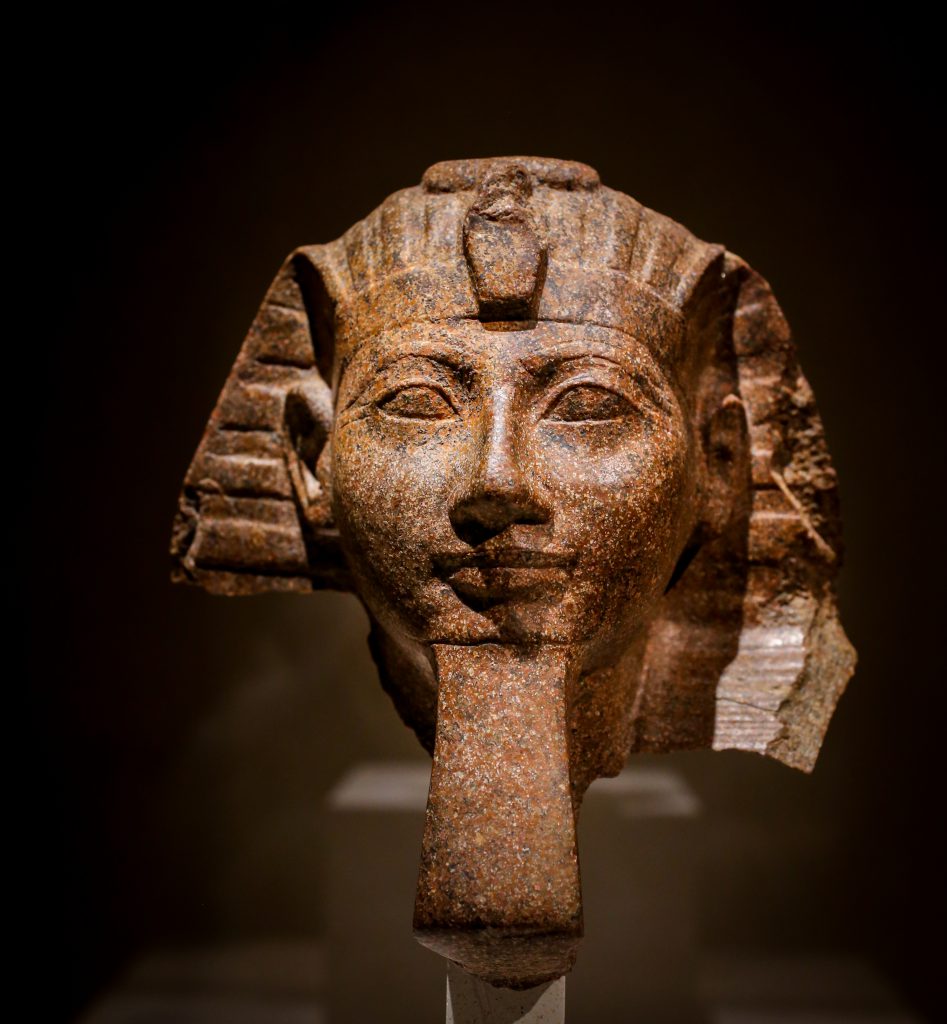
Approximately four thousand years ago in Egypt, a pharaoh was violently attacked. This attack was not physical, but rather spiritual, as the ruler had been dead for twenty years. The attack was an act of damnatio memoriae, the damnation of memory. Someone had smashed the statues that represented the royal noble and attempted to remove the pharaoh’s name and identity from history. Who was this pharaoh, and what sort of decisions had the pharaoh made, and what sort of actions were taken while on the throne, to make somebody so furious? The reason behind this violent attack was because the pharaoh who suffered the damnation of memory was Hatshepsut, and she was a woman. According to traditional Egyptian society, she should have never been Pharaoh, and it wasn’t until about one hundred years ago that anyone even knew of Hatshepsut.1
Our story begins in Egypt, one of the most powerful of the ancient empires. The position of Pharaoh was more than just a king in the Egyptian world. A Pharaoh controlled most of the Egyptian land and controlled its military. In addition to these responsibilities, pharaohs built many temples, granaries, barges, pyramids, sculptures, as the more items that were built during one’s reign, the more surface area that the pharaoh had, essentially etching their lineage and triumphs as rulers. Building things during their time on the throne ruling was important because it was believed in Egyptian tradition that eternal life after death was dependent on a form of memory of the pharaoh that would continue existing in the real world. Thus, all the elaborate statues, temples, and tombs that are known about and still exist in modern times were initially built to guarantee that the spirits of the pharaohs lived forever, being kept in the memories of the living in further generations.2

The most straightforward way to gain the role of pharaoh was to be born the eldest son of the current pharaoh and queen. However, this was not as easy as it sounds. Pharaohs were polygamous, meaning they were married to several wives, but only one wife was considered to be the ruling queen. Additionally, a harem would be kept by the pharaohs. This harem was not royal and was considered to be “low-born.” If the queen had not given birth to a son by the time the land of Egypt needed a new pharaoh, a son from one of the women in the harem would be eligible to become heir. Thus, the system could become messy, as is evidenced in the case of our protagonist, Hatshepsut.3
Hatshepsut’s father was a man named Thutmose I. He was a charismatic man and according to texts, an effective leader. At the beginning his reign in 1500 B.C.E., he was a driven and focused military man who expanded the Egyptian kingdom by force. When King Thutmose I died, even though Hatshepsut was the child of Thutmose I and Queen Ahmose, the throne was not passed to Hatshepsut, but rather to Thutmose II. Thutmose II was in bad health at the time of his father’s death and his mother was not a royal; she was a secondary wife to Thutmose I.4
However, the story only gets more conventional from here. In Egyptian custom, it was not bizarre, or uncommon, for royal children to marry their siblings. At twelve years old, Hatshepsut married her half-brother Thutmose II, who had just been given the new role of pharaoh. Hatshepsut had given birth to a daughter before her husband had died, so the throne then again was passed to a son, not to Hatshepsut. The kingdom of Egypt was then to be ruled by Thutmose III. However, there was a problem naming Thutmose III king. He was only a baby at the time. Thus, Egypt needed someone to take over the throne and serve as regent while waiting for Thutmose III to mature and learn the skills he needed in order to become a strong leader. Because Thutmose III was a non-royal and Hatshepsut had been a royal since birth, she then acted as queen regent.5
During Hatshepsut’s first few years as acting ruler, everything was going according to plan and running smoothly. Thutmose III learned and grew while Hatshepsut took care of the work and looked after the land of Egypt. However, before Thutmose’s eighth birthday, Hatshepsut had proposed a promotion to Thutmose III and the elites of ancient Egypt. She wanted to become Thutmose III’s co-pharaoh.6

Thutmose and the elites of Egypt approved of the progressive idea and Hatshepsut was then made co-pharaoh of Egypt. Yet, this was not an innocent plan. While in position as queen regent, Hatshepsut had chosen talented non-royals to step into the leading positions of her regime and composed the new Egyptian leadership under Hatshepsut, rather than having individuals from elite families with questionable loyalty in such coveted and powerful positions. Thus, in order to sustain their positions, Hatshepsut had to stay ruling on the throne. However, holding on to the title as pharaoh was not an automatic given that Hatshepsut had to obtain and keep the loyalty and trust of the Egyptian people. She acquired this loyalty by launching an ambitious public infrastructure project.7
Ancient Egyptian infrastructure was different from the roads and buildings that some modern societies may have today. For example, during her reign, Hatshepsut had commissioned the construction of some of the largest Egyptian obelisks ever constructed, towering at one hundred feet tall. One hundred feet may not seem so tall today, but keep in mind, obelisks were made out of one solid piece of stone and some were built and erected by hand, without the convenience of modern technology and building tools. In addition to her building of obelisks, Hatshepsut oversaw the construction of one of the most impressive buildings to ever exist in the ancient world, an impressive temple at Deir el-Bahiri.8
This temple consisted of pools and gardens at its lower levels, and over one hundred giant statues of the pharaoh herself could be found throughout the temple. The walls were covered with inscriptions that illustrated and glorified Hatshepsut’s achievements as a ruler. Apart from building, Hatshepsut intended to establish and reinforce the legitimacy of her rule as Pharaoh by establishing her brand. She achieved this by not only changing her name, but also by changing her gender and adding an element of mythology to the story of her birth. Hatshepsut ensured that through Egypt, people believed that her mother had become pregnant by the god Aman, who had taken on the appearance of her father. She also changed her name to Maatkare; maat meaning truth, ka meaning soul, and Re the sun god. Hatshepsut also wanted to start being depicted as a man. Overall, she went through quite a transformation during her rule.9
Although in early statues and carvings Hatshepsut was illustrated as a woman, she later started being portrayed as a bare-chested, flail-and-hook-wielding man. This was not intended to confuse others into thinking she had been a man this whole time, but rather to emphasize that she deserved to be on the throne. Egyptian art depicted subjects not necessarily as what they actually were, but rather what they metaphorically were. Written texts conclusively confirm that Hatshepsut was a woman; she was just a woman who was depicted as a man. The reason for this gender change still remains unknown, though many have theorized that Hatshepsut was attempting to legitimize her rule.10
While Hatshepsut was carrying out her transformation and attempting to ensure her legitimate claim to the throne, her stepson/nephew was experiencing his own transformation, that of becoming a man capable of ruling Egypt without a regent or co-pharaoh. Hatshepsut’s biggest threat to her role, and permanence, as pharaoh was Thutmose III. While in charge, Hatshepsut made sure Thutmose III would be ready for his role as pharaoh. She had him educated as a scribe, a priest, and a soldier. He excelled at being a soldier and eventually was even promoted to Commander in Chief of the army. Hatshepsut made sure Thutmose III was a well-rounded individual. Despite setting Thutmose III onto a path for eventual greatness, Hatshepsut was still focused on legitimizing her throne and increasing Egypt’s power, influence, and accomplishments.11

In 1457 B.C.E., after a long and successful twenty-two year reign, Hatshepsut died. Thutmose II was then finally able to claim and maintain his position as sole Pharaoh of ancient Egypt. All the years of learning paid off as Thutmose III would also go on to have a successful reign as pharaoh, following in his mother’s footsteps. Utilizing his skills as a military leader, Thutmose III expanded Egypt’s control by force, and made the land of Egypt one of the wealthiest empires in the ancient world. For everything Hatshepsut had achieved as pharaoh, her name should have been remembered forever. However, history tells a different story.12
It wasn’t until the early 1900s that anyone knew that Hatshepsut had ever existed. Hatshepsut’s name hadn’t been spoken or read for such a long time due to her stepson destroying all records of her existence. About twenty years after his mother’s reign, Hatshepsut’s statues, monuments, engravings of her name, and carvings had been destroyed and replaced, in all likelihood, with that of her husband, Thutmose II. In ancient Egypt, the cause of actions such as this wasn’t to simply destroy a legacy, but rather a curse to damnation.13
With no statues or monuments to remember Hatshepsut by, she would not be able to enjoy the afterlife. Why did Thutmose III try to erase Hatshepsut’s name and legacy from history? The reason for this horrible action remains a mystery to this day, leaving historians curious. Because of Thutmose III, records of Hatshepsut’s achievements had been erased and will probably never be rediscovered.14
About three thousand years after Hatshepsut’s reign, in 1903, British archeologist Howard Carter discovered a non-royal tomb, today known as KV60. Inside the tomb, the discoveries included some mummified geese, Hatshepsut’s royal wet nurse, and the mummy of another unidentified female. Another one hundred years later, in 2007, thanks to advanced technology, a CT scan confirmed that the unidentified corpse from one hundred years prior was Hatshepsut.15
Once it was confirmed that the mummy was that of Hatshepsut, tests were then performed to determine the cause of her death. The CT scans performed in 2007 depicted that Hatshepsut was in bad health at the time of her death, and according to the evidence found in her pelvic region and spine, she suffered from cancer. A vial of skin cream had been found among Hatshepsut’s possessions; this wasn’t too unusual as known cases of skin disease ran in her family.16
However, pharmacologists discovered Benzo A Pyrene, a carcinogenic substance, in the skin cream. Due to the memory of her rule being restored, Hatshepsut’s spirit can now live on for eternity.
- Sarah E. Bond, “Erasing the Face of History,” The New York Times, May 14, 2011. https://www.nytimes.com/2011/05/15/opinion/15bond.html ↵
- National Geographic Society, “Pharaohs.” National Geographic, March 1, 2019. https://www.nationalgeographic.org/encyclopedia/pharaohs/ ↵
- “The Family and Social Trends: Overview.” In Ancient Egypt, 2615 – 332 B.C.E., 186. Vol. 5 of World Eras. (Detroit, MI: Gale, 2002). ↵
- Emily Teeter, “Museum Review: Hatshepsut and Her World,” American Journal of Archaeology 110, no.4 (2006): 650. ↵
- Emily Teeter, “Museum Review: Hatshepsut and Her World,” American Journal of Archaeology 110, no.4 (2006): 651. ↵
- Emily Teeter, “Museum Review: Hatshepsut and Her World,” American Journal of Archaeology 110, no.4 (2006): 652-653. ↵
- Emily Teeter, “Museum Review: Hatshepsut and Her World,” American Journal of Archaeology 110, no.4 (2006): 653. ↵
- “Hatshepsut, the Woman Who Was King,” video file, 3:51, YouTube, posted by NBC News Learn, April 30, 2020, https://www.youtube.com/watch?v=pMgqPsNjYD0. ↵
- Uroš Matić, “(De)queering Hatshepsut: Binary Bind in Archaeology of Egypt and Kingship Beyond the Corporeal,” Journal of Archaeological Method and Theory 23, no. 3 (2016): 810 ↵
- Uroš Matić, “(De)queering Hatshepsut: Binary Bind in Archaeology of Egypt and Kingship Beyond the Corporeal,” Journal of Archaeological Method and Theory 23, no. 3 (2016): 812 ↵
- Emily Teeter, “Museum Review: Hatshepsut and Her World,” American Journal of Archaeology 110, no.4 (2006): 650. ↵
- “Hatshepsut, the Woman Who Was King,” video file, 3:51, YouTube, posted by NBC News Learn, April 30, 2020, https://www.youtube.com/watch?v=pMgqPsNjYD0. ↵
- Sarah E. Bond, “Erasing the Face of History.” The New York Times, May 14, 2011. https://www.nytimes.com/2011/05/15/opinion/15bond.html ↵
- “Hatshepsut, the Woman Who Was King,” video file, 3:51, YouTube, posted by NBC News Learn, April 30, 2020, https://www.youtube.com/watch?v=pMgqPsNjYD0. ↵
- “Discovery of Queen Hatshepsut’s mummy, presser,” video file, 2:37, YouTube, posted by AP Archive, July 21, 2015, https://www.youtube.com/watch?v=ABpXwK85MIY ↵
- Peter Kenyon, “CT Scan, DNA Tests Help ID Mummy as Hatshepsut.” NPR, June 27, 2007. https://www.npr.org/templates/story/story.php?storyId=11478188 ↵



29 comments
Shanita Frazier
This was a very interesting article to read. It depicts the process of Hatshepsut making her rule and not so much discussing her life entirely. I like how the author drives in on the knowledge of Hatshepsut without going off topic or switching gears often. This article reminds me of the strong women leaders that many may not know about.
Brittney Carden
This was such an incredibly written and informative article! Egypt has many fascinating figures in history, but I have to say Hatshepsut is one of my favorites. I really loved reading about her journey and how she both took the throne and came into her own power. She was a magnificent queen and ruler and an intelligent woman with a keen eye for architecture.
Paul Garza
Wow! I love how this article tells the unknown story of Hatshepsut and her time as pharaoh, doing the opposite of what Thutmose III did. This article was such a fun read. I love how it has a serious and unexpected twist when the passing of power to Thutmose III is said to go smoothly as his mother intended and then it doesn’t. This article was very informational and tells a compelling story of a powerful woman in history!
Danielle Litman
Hatshepsut is a great example of a strong female leader, but was erased in history due to her gender. The author did a great job of explaining how Hatshepsut grew into becoming a pharaoh,especially since it was a male patriarch. I found it interesting that Hatshesput started to transition into a male, just to earn the respect she all ready deserved . I did not know that “Egyptian art depicted subjects not necessarily as what they actually were, but rather what they metaphorically were”.
Aneesa Zubair
Congrats on your award! Hatshepsut is such an interesting figure in Egyptian history. I enjoyed reading about how she came to take the throne, beginning as queen regent to fulfill the responsibilities of Thutmose III before becoming a celebrated ruler who commissioned infrastructure that we can still see today.
Faith Chapman
The thing I respected most while reading this was the part about how Hatshepsut was so fitting to be a pharaoh, that she was depicted in art as a man not because she saw herself as or wanted people to think she was a man, but because that’s how legitimate she would be as a full pharaoh; being depicted as a man was not something that undermined her or her womanhood, nor was it ever intended to, was the impression I had got. I feel like if this was done seriously today, like if house husbands/stay-at-home dads were depicted as women or if Eminem was depicted as black in a non-political cartoon manner, this would be viewed as a major insult or taboo among the general public and maybe the subject despite the message being overtly positive.
Malleigh Ebel
I love the mystery this article has, as well as it coming full circle, and restoring Hatshepsut life for eternity after Thutmose III tried to erase her from history! It makes me very curious as to why he would do this, except for the fact that allowing the memory of a female Pharaoh could cause first-born girls to be allowed rule, which would threaten the patriarchy. I also found it very clever of her to try to be depicted more legitimately by being portrayed as a man, having more loyal people by her side rather than strictly royalty, changing her name, and claiming to be a child of Aman.
Mariana Mata
Learning about Hatshepsut’s story made me realize how many other stories of strong woman leaders we have yet to discover. We can learn from her story that a female in power has always been, in some sense, unwanted or even spiteful. But as much as Thutmose III wanted to eradicate her legacy, her reign opened doors for other civilizations to become even more progressive in terms of women in power.
Madeline Emke
This article is incredibly interesting because it depicts the process of Hatshepsut legitimizing her rule rather than discussing the entirety of her life, which might have led to an incredibly lengthy article. The author wrote in a succinct yet knowledgeable language that allowed her to summarize the rule of Hatshepsut without losing focus on the topic.
Alexandria Garcia
Such and interesting topic. I loved how you crafted this into a historical sabbatical that the reader has to navigate. This was great way to learn about ancient Egyptian Pharaohs. Especially the women that we never knew were rulers of a mighty nation.